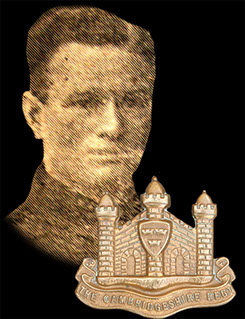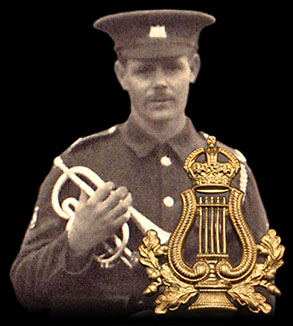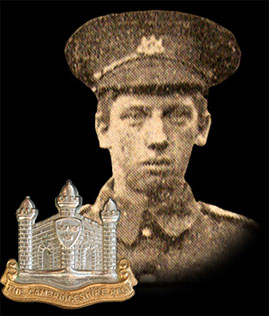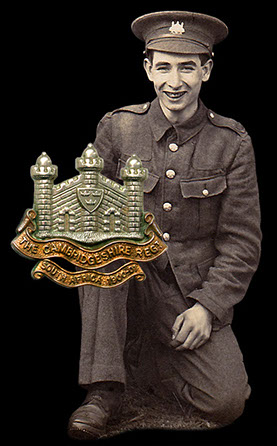
Who Were
The Cambs
The Cambs
at War
1/1st Btn 1914-1919
1914 - 1/1st Overview
1915 - 1/1st Overview
1915 - St Eloi
1915 - Fosse Wood
1916 - 1/1st Overview
1916 - The Schwaben
1916 - St Pierre Divion
1917 - 1/1st Overview
1917 - St Julien
Insignia, Medals & Books
Remembering The Cambs
Biographies
About Us &
This Site
Arrival on the Somme - 26th August to 2nd September 1916
With the 39th Division’s move to the Somme, it was now part of V Corps in General Gough’s Fifth Army. The 1/1st Cambridgeshire Regiment, part of 39th Division’s 118th Brigade, would move into the line on August 26 to an area just north of the River Ancre in what was the left subsection (Knightsbridge/Hamel) of the brigade’s frontage. Today this area is easily found in the fields in front of the car park to the Newfoundland Memorial Park.
Having moved into the line at 4.30pm, during which British artillery was close firing to destroy the German barbed wire, the battalion settled into their new life on the Somme. Lt-Col Ted Riddell, writing in the battalion history, describes the scene:
The trenches (cut through red clay) showed little improvement on those around Festubert when it rained heavily (as it did on 31st), though there was high ground affording very good observation of the country behind the German lines far beyond Serre, Miraumont and Grandcourt.
A thousand yards to the south lay the ruins of Hamel, perched on a hill a hundred feet above the wooded and marshy valley of the Ancre,” he recalled. “Beyond the Ancre the ground rose in a uniform slope for some four or five hundred yards to the great German fortress known as the Schwaben Redoubt, beyond which lay what had been the village of Thiepval.
Less than two months later in conjunction with other battalions in 39th Division, the Cambridgeshires would make their name capturing the summit of the Schwaben Redoubt.
On August 26, the Cambridgeshires had B and D Companies in the front line (Gordon Trench), support trench (Roberts Trench) and behind, with two platoons of A Coy. The remainder of A Coy were at Fort Moulin and C Coy and Btn HQ in Knightsbridge (a communication trench). That first night three patrols of D Coy were sent out and found the German wire easy to get through.
Intermittent bombardments continued the next day (August 27) with more patrols out at night, when the enemy line seemed to be lightly held. Wounded on patrol was L/Cpl Fred Lemmon, of Wimblington; he survived the war and died, aged 72, a retired farmer, in 1970. Another man wounded was Pte Arthur Pleasants, of Wisbech, who would be wounded again in 1918 and die of those injuries on April 27, 1918.
The British bombardment continued on August 28, with the Germans retaliating and damaging the British line at New Trench and Regent Street. The men were kept busy improving the old trenches and carrying up supplies. One man was killed, Pte Horace Franklin Thompson, of Littleport, who was hit by a British shell cross firing over their lines. He is buried close by at Knightsbridge Cemetery, Mesnil-Martinsart, along with numerous of his Cambs Regt comrades from the August/September period.
His colleague Pte Arthur Eley, of Soham, sustained shellshock after seeing Thompson killed and being knocked out when another shell exploded while he was talking to an officer. He woke up four days later to find himself in a casualty clearing station, before been sent to England.
On the same day, Pte Walter Edwin Croote, of Angle Bridge, near Whittlesey, was wounded. The officer in command of D Coy, Capt John Reynolds Stickland, wrote to Croote’s parents:
He was my chief orderly and was sleeping in a little shelter he had erected for himself just outside my dugout. A shell hit the parapet just where he was and knocked it in, burying your son underneath the debris. We dug him out, but found his right leg badly broken, as well as his right arm. He was badly hurt but was wonderfully brave.
Coote was moved to a hospital behind the lines, but died of his wounds the following day, aged 21. He is buried at Couin British Cemetery
Another man of D Coy to sustain leg and arm injuries was Pte Albert Parish, of March, who was hit while on patrol during the night of August 28/29. He was sent to hospital at Bury St Edmunds; he was later posted to the Suffolk Regiment and wounded again in 1917.
This artillery duel continued the following day (August 29) and patrols discovered the German wire was smashed and there was scarcely any signs of the enemy in his front line. The bombardment continued on the last day of August, as the men continued to repair and “clear communication trenches of mud which the excessively bad weather has engendered”. The battalion lost four killed and five wounded on August 29 and 30.
Among them was Pte Fred Cooper, a married man of Elm, near Wisbech, who is also buried in the British lines at Knightsbridge Cemetery. His pal, Pte George Else, wrote:
His death was caused by a shell exploding in the trench.
Another man of C Coy, L/Sgt Hugh Langford is buried near Cooper. Aged 24, he had previously served in D coy, when in mid-1916 he was mentioned for fearless consolidation of two mine craters over several nights at Givenchy. Promoted to L/Sgt, he had only recently transferred to C Coy.
A private from Cambridge called Sid Edwards was wounded in the face on the same day and shipped home to the UK.
Once again D Coy sustained casualties. They included Pte Fred Hodson, of 13 Platoon, one of D Coy’s four stretcher bearers who was killed while helping a wounded man. L/Cpl Hughes Collingwood, of March, wrote to Hodson’s parents:
The Germans were bombarding our trenches, during which two men were mortally wounded, and while Fred, in his capacity as a stretcher bearer, was rendering them what little aid lay in his power, another shell fell in the same spot killing him outright.
CSM George Burbridge, of D Coy, wrote:
Some of his work during the regiment’s first memorable weeks in action around Ypres will never be forgotten by those who came under his care.
Aged 21, Hodson was buried in Hamel Military Cemetery, although his grave was later lost and he is commemorated by a special memorial in that burial ground.
Cpl Freddie Marshall, also of D Coy 13 Platoon, was killed, aged 25, when a shell came through the roof of his dugout. He was the only son of Mr and Mrs George Marshall, of the Golden Lion Hotel, in Market Place, March. Capt Stickland was one of many to write to his parents:
I made him the company wiring corporal and as such he has done some very fine work. It is no easy job to be in charge of men putting up barbed wire when all kinds of hate are flying about.
September 1 and 2 were similar days with intermittent bombardments, during which a shell hit B Coy’s headquarters. Fatigue work continued and during the night an overland route was laid out from Knightsbridge to the forward trenches in preparation for an attack on September 3. Several men were wounded by a shell hitting a working party in Pond Street trench.
On September 2, the Cambridgeshires left the front line to occupy trenches about one mile back in close reserve, while other units of 39th Division took over ready for an attack eastwards towards Beaucourt, while further south the XIV Corps would be engaged in the Battle of Guillemont.
The Cambridgeshires were about to become embroiled in their first battle of their service on the Somme in 1916.
Back to the top of the page.

Horace Thompson, killed August 28th.

Arthur Eley left severely shellshocked.

Walter Croote, died of wounds August 29th.

A young Freddie Marshall before the War.

This site went live on the 14th February 2015 to mark 100 years since the 1/1st Cambs went off to war.
WE WILL REMEMBER THEM
Email us: cambsregt@gmail.com
Copyright 2015, 2016, 2017, 2018, 2019 by Felix Jackson. The information and images on this site should not be reproduced without prior permission.